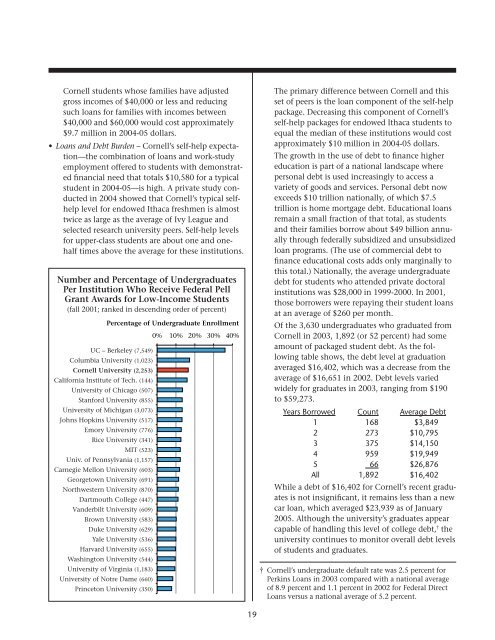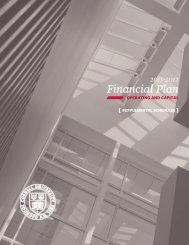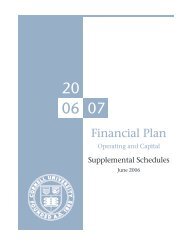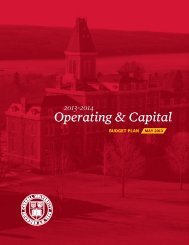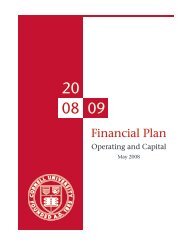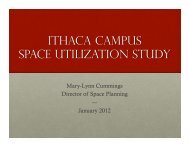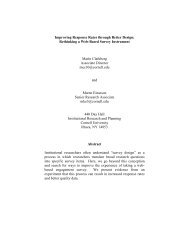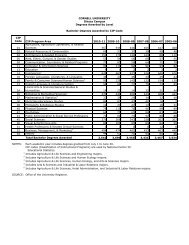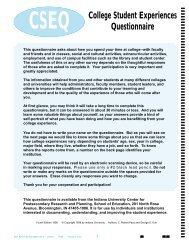Undergraduate Student Access - Cornell University Division of ...
Undergraduate Student Access - Cornell University Division of ...
Undergraduate Student Access - Cornell University Division of ...
You also want an ePaper? Increase the reach of your titles
YUMPU automatically turns print PDFs into web optimized ePapers that Google loves.
<strong>Cornell</strong> students whose families have adjustedgross incomes <strong>of</strong> $40,000 or less and reducingsuch loans for families with incomes between$40,000 and $60,000 would cost approximately$9.7 million in 2004-05 dollars.• Loans and Debt Burden – <strong>Cornell</strong>’s self-help expectation—thecombination <strong>of</strong> loans and work-studyemployment <strong>of</strong>fered to students with demonstratedfinancial need that totals $10,580 for a typicalstudent in 2004-05—is high. A private study conductedin 2004 showed that <strong>Cornell</strong>’s typical selfhelplevel for endowed Ithaca freshmen is almosttwice as large as the average <strong>of</strong> Ivy League andselected research university peers. Self-help levelsfor upper-class students are about one and onehalftimes above the average for these institutions.Number and Percentage <strong>of</strong> <strong>Undergraduate</strong>sPer Institution Who Receive Federal PellGrant Awards for Low-Income <strong>Student</strong>s(fall 2001; ranked in descending order <strong>of</strong> percent)UC – Berkeley (7,549)Columbia <strong>University</strong> (1,023)<strong>Cornell</strong> <strong>University</strong> (2,253)California Institute <strong>of</strong> Tech. (144)<strong>University</strong> <strong>of</strong> Chicago (507)Stanford <strong>University</strong> (855)<strong>University</strong> <strong>of</strong> Michigan (3,073)Johns Hopkins <strong>University</strong> (517)Emory <strong>University</strong> (776)Rice <strong>University</strong> (341)MIT (523)Univ. <strong>of</strong> Pennsylvania (1,157)Carnegie Mellon <strong>University</strong> (603)Georgetown <strong>University</strong> (691)Northwestern <strong>University</strong> (870)Dartmouth College (447)Vanderbilt <strong>University</strong> (609)Brown <strong>University</strong> (583)Duke <strong>University</strong> (629)Yale <strong>University</strong> (536)Harvard <strong>University</strong> (655)Washington <strong>University</strong> (544)<strong>University</strong> <strong>of</strong> Virginia (1,183)<strong>University</strong> <strong>of</strong> Notre Dame (660)Princeton <strong>University</strong> (350)Percentage <strong>of</strong> <strong>Undergraduate</strong> Enrollment0% 10% 20% 30% 40%The primary difference between <strong>Cornell</strong> and thisset <strong>of</strong> peers is the loan component <strong>of</strong> the self-helppackage. Decreasing this component <strong>of</strong> <strong>Cornell</strong>’sself-help packages for endowed Ithaca students toequal the median <strong>of</strong> these institutions would costapproximately $10 million in 2004-05 dollars.The growth in the use <strong>of</strong> debt to finance highereducation is part <strong>of</strong> a national landscape wherepersonal debt is used increasingly to access avariety <strong>of</strong> goods and services. Personal debt nowexceeds $10 trillion nationally, <strong>of</strong> which $7.5trillion is home mortgage debt. Educational loansremain a small fraction <strong>of</strong> that total, as studentsand their families borrow about $49 billion annuallythrough federally subsidized and unsubsidizedloan programs. (The use <strong>of</strong> commercial debt t<strong>of</strong>inance educational costs adds only marginally tothis total.) Nationally, the average undergraduatedebt for students who attended private doctoralinstitutions was $28,000 in 1999-2000. In 2001,those borrowers were repaying their student loansat an average <strong>of</strong> $260 per month.Of the 3,630 undergraduates who graduated from<strong>Cornell</strong> in 2003, 1,892 (or 52 percent) had someamount <strong>of</strong> packaged student debt. As the followingtable shows, the debt level at graduationaveraged $16,402, which was a decrease from theaverage <strong>of</strong> $16,651 in 2002. Debt levels variedwidely for graduates in 2003, ranging from $190to $59,273.Years Borrowed Count Average Debt1 168 $3,8492 273 $10,7953 375 $14,1504 959 $19,9495 66 $26,876All 1,892 $16,402While a debt <strong>of</strong> $16,402 for <strong>Cornell</strong>’s recent graduatesis not insignificant, it remains less than a newcar loan, which averaged $23,939 as <strong>of</strong> January2005. Although the university’s graduates appearcapable <strong>of</strong> handling this level <strong>of</strong> college debt, † theuniversity continues to monitor overall debt levels<strong>of</strong> students and graduates.† <strong>Cornell</strong>’s undergraduate default rate was 2.5 percent forPerkins Loans in 2003 compared with a national average<strong>of</strong> 8.9 percent and 1.1 percent in 2002 for Federal DirectLoans versus a national average <strong>of</strong> 5.2 percent.19


